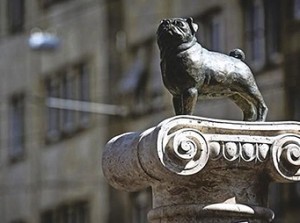Dog Statues – Pug Memorial in Winnenden, Germany
228 – The Annual, 2017-18
by Ria Hörter
 Winnenden is a city of about 30,000 people, situated in the federal state of Baden-Württemberg in southwest Germany.
Winnenden is a city of about 30,000 people, situated in the federal state of Baden-Württemberg in southwest Germany.
A memorial in front of the Winnental Palace is probably unique: the stone sculpture commemorates the Pug owned by Karl alexander (1684-1737), Duke of Württemberg-Winnental from 1698 to 1737. The Mopsendenkmal (Pug memorial) shows Fortunatis, born in 1713, whose name means “fortunate one.” The epitaph on the monument tells the story of Fortunatis’s unbelievable adventure.
The Story Behind the Memorial
Born in the city of Stuttgart, Karl Alexander spent his childhood with his siblings in Castle Winnental in Winnenden. A born soldier; he fought in the War of the Spanish succession (1701-14) and served as field marshall in the service of the austrian emperor Charles VI of Habsburg (1685-1740). Karl and Charles had the same goal: to chase the turks out of Europe.
Karl took part in campaigns in different parts of Europe; for example, his army liberated large parts of the Balkans from the Turkish supremacy. In 1717, when he left his castle in Winnenden for the final battle against the Turks in Belgrade, he decided to bring his favorite dog Fortunatis – the “court Pug” – with him. On august 17, 1717, the Duke and Fortunatis were present at the conquest of the city but, in the heat of battle the duke and his dog were separated. While Karl alexander celebrated the victory in the company of fellow generals, Fortunatis wandered around searching for his master. Karl alexander assumed that Fortunatis had died. After all, a battlefield is not a safe place for a small dog.
But the Pug survived; in a journey of 11 days, Fortunatis allegedly walked back to Winnenden, a distance of about 745 miles (1,200 km). The duke’s staff immediately recognized the dog and celebrated his safe return to Winnenden with delicious treats made by the cook, and every servant coddled him. Fortunatis’s long life is proof that he had a good life after his adventure. In 1733 at 20 years old, Fortunatis died without seeing its master again, and was buried in the garden of the castle.
Click here to read the complete article228 – The Annual, 2017-18
Short URL: https://caninechronicle.com/?p=137627
Comments are closed











